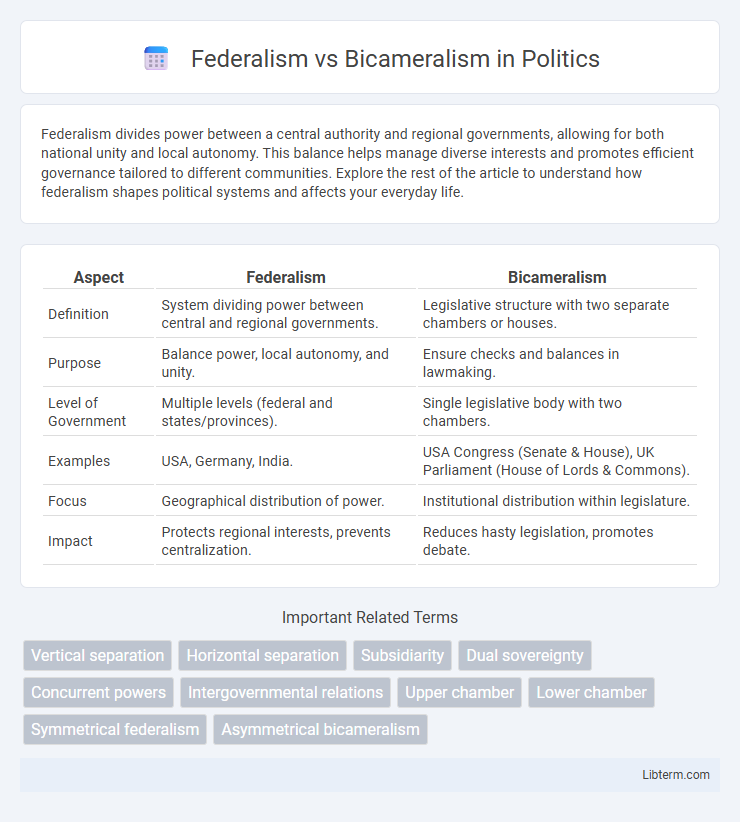Federalism divides power between a central authority and regional governments, allowing for both national unity and local autonomy. This balance helps manage diverse interests and promotes efficient governance tailored to different communities. Explore the rest of the article to understand how federalism shapes political systems and affects your everyday life.
Table of Comparison
| Aspect | Federalism | Bicameralism |
|---|---|---|
| Definition | System dividing power between central and regional governments. | Legislative structure with two separate chambers or houses. |
| Purpose | Balance power, local autonomy, and unity. | Ensure checks and balances in lawmaking. |
| Level of Government | Multiple levels (federal and states/provinces). | Single legislative body with two chambers. |
| Examples | USA, Germany, India. | USA Congress (Senate & House), UK Parliament (House of Lords & Commons). |
| Focus | Geographical distribution of power. | Institutional distribution within legislature. |
| Impact | Protects regional interests, prevents centralization. | Reduces hasty legislation, promotes debate. |
Introduction to Federalism and Bicameralism
Federalism divides sovereignty between national and subnational governments, allowing multiple levels of authority to coexist and share power within a single state. Bicameralism structures the legislature into two separate chambers, typically an upper and lower house, to balance representation and prevent legislative dominance. Both federalism and bicameralism enhance political stability by distributing power and fostering checks within government institutions.
Defining Federalism: Key Features and Principles
Federalism is a constitutional system in which power is divided between a central government and constituent political units, such as states or provinces, allowing each level to govern autonomously within its jurisdiction. Key features of federalism include the constitutionally guaranteed division of authority, shared sovereignty, and mechanisms for resolving conflicts between national and regional laws. Principles such as decentralization, self-rule, and cooperation among governments ensure the balance of power and protect regional interests within a unified nation.
What is Bicameralism? Structure and Purpose
Bicameralism refers to a legislative system divided into two separate chambers or houses, typically known as the upper and lower houses, such as the Senate and the House of Representatives in the United States. This structure allows for a system of checks and balances within the legislature, promoting more thorough debate, preventing hasty legislation, and ensuring representation of different interests, such as states or population groups. The purpose of bicameralism is to balance power distribution, provide diverse perspectives in lawmaking, and enhance the quality and accountability of legislative decisions.
Historical Origins of Federalism and Bicameralism
Federalism traces its origins to the 18th century, notably in the formation of the United States Constitution in 1787, where power was divided between national and state governments to balance authority and accommodate diverse regional interests. Bicameralism dates back to medieval England, with the establishment of the Parliament comprising the House of Lords and the House of Commons, designed to represent different social classes and provide a system of checks and balances within the legislature. Both federalism and bicameralism emerged as mechanisms to prevent the concentration of power and to ensure representation of distinct groups within a political system.
Comparative Analysis: Federalism vs Bicameralism
Federalism divides power between national and regional governments, promoting local autonomy and accommodating diverse political units within a single state. Bicameralism structures the legislature into two chambers, typically balancing representation by population with representation by region or social interests, enhancing deliberation and preventing hasty legislation. Comparative analysis reveals federalism emphasizes territorial sovereignty and policy differentiation, whereas bicameralism focuses on legislative checks and balances through dual-chamber governance.
Benefits and Challenges of Federalism
Federalism offers benefits such as promoting regional autonomy, allowing diverse states to address local needs effectively while maintaining national unity. It enhances political stability by distributing power across multiple levels of government, which can prevent the concentration of authority. However, challenges include potential conflicts between state and federal laws, unequal resource distribution, and complexity in policy implementation across jurisdictions.
Advantages and Drawbacks of Bicameralism
Bicameralism offers advantages such as enhanced checks and balances by providing two legislative chambers that review laws independently, which helps prevent rushed or poorly considered legislation. It ensures better representation by allowing different interests--often regional and population-based--to be reflected in policy-making, thereby increasing legislative legitimacy. However, bicameralism can lead to legislative gridlock, slowing down lawmaking processes and complicating consensus-building due to potential conflicts between the two chambers.
Real-World Examples: Federal and Bicameral Systems
Federalism divides power between national and regional governments, as seen in the United States where states exercise significant autonomy. Bicameralism features two legislative chambers, exemplified by the UK Parliament with the House of Commons and House of Lords balancing representation and review. Countries like Germany combine federalism and bicameralism through the Bundesrat representing state governments alongside the Bundestag, ensuring regional interests influence national legislation.
Impact on Governance and Policy-Making
Federalism divides power between national and regional governments, enabling localized policy-making that addresses diverse needs and promotes political stability through shared sovereignty. Bicameralism structures the legislature into two chambers, ensuring thorough debate, preventing hasty legislation, and representing different interests, which enhances policy scrutiny and balance. Both systems impact governance by distributing authority: federalism balances power across territorial units, while bicameralism mediates among social or regional groups within the law-making process.
Conclusion: Balancing Federalism and Bicameralism
Balancing federalism and bicameralism requires structuring government institutions to ensure both regional representation and effective legislative deliberation. Federalism distributes power between central and regional governments, while bicameralism divides the legislature into two chambers to balance interests and prevent dominance by a single group. Achieving equilibrium between these principles strengthens democratic governance by promoting accountability, inclusiveness, and stability across diverse political entities.
Federalism Infographic

 libterm.com
libterm.com